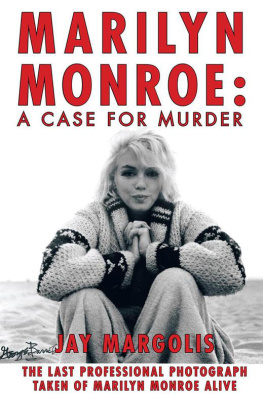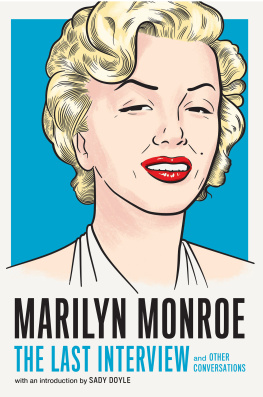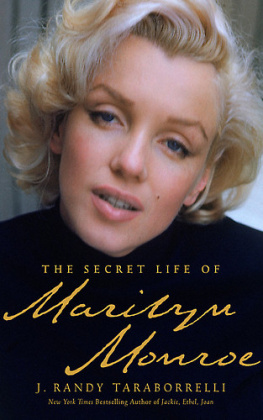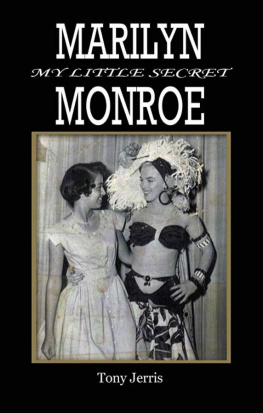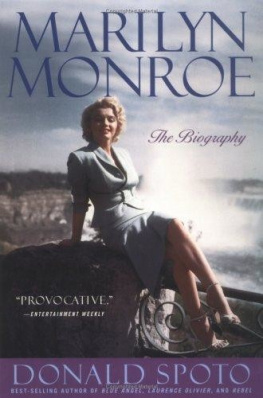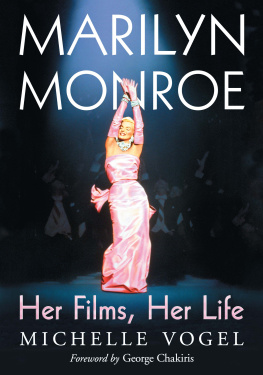Marilyn Monroe
Hollywood Legends Series
Carl Rollyson, General Editor

MARILYN
MONROE
A Life of the Actress
REVISED AND UPDATED
Carl Rollyson

www.upress.state.ms.us
The University Press of Mississippi is a member of the Association of American University Presses.
Illustration on : Marilyn Monroe (c. 1952)
All illustrations are from the authors collection.
Copyright 2014 Carl Rollyson
All rights reserved
Manufactured in the United States of America
First printing 2014

Library of Congress Cataloging-in-Publication Data
Rollyson, Carl E. (Carl Edmund)
Marilyn Monroe : a life of the actress / Carl Rollyson. Revised and updated [edition].
pages cm. (Hollywood legends series)
Originally published: Ann Arbor, Michigan : UMI Research Press, 1986.
Includes bibliographical references and index.
Includes filmography.
ISBN 978-1-61703-978-2 (pbk.) ISBN 978-1-61703-979-9 (ebook) 1. Monroe, Marilyn, 19261962. 2. Motion picture actors and actressesUnited StatesBiography. I. Title. PN2287.M69R65 2014
791.4302'8092dc232013042774
British Library Cataloging-in-Publication Data available
Contents
Acknowledgments
Several interviews were valuable owing to the insights Monroes friends and business associates were able to supply concerning the shaping of the actresss life and attitude toward her art. Bruce Minnix, my friend and professional colleague, helped to arrange the initial interviews with Ralph Roberts and Steffi Sidney, the daughter of Hollywood columnist Sidney Skolsky. Sidney made a significant contribution to this biography by shrewdly commenting on an early draft and by questioning some of the facts included in other books on Monroe. Because her father was ailing and no longer able to grant interviews, she relayed a few of my questions to him. She also discussed her own perceptions of a Monroe who delighted in carefully crafting her career in an almost conspiratorial way that included Skolsky as her confidant. For example, when Ben Hecht had a draft of My Story ready for Monroe to check, she read passages from it over the phone to Skolsky, asking his opinion on how they sounded. Although Skolsky wrote a great deal about the actress, he revealed very little about those things she confided to him in strictest confidence. As a result, even his daughter could not say for sure how much she believed in the stories her father and Monroe concocted together. And Monroeprecisely because she held on to parts of herself that were not for distributionbecomes a more complex figure.
Ralph Roberts kindly reviewed what had been written about him in other sources and responded readily to questions about the actresss development of her talent. He conveyed a solid impression of Monroes working life as an actress and of her fervent desire to educate herself. Our discussions of the Method led him to recommend an interview with Ellen Burstyn, who generously shared with me her experience as a movie actress. She suggested ways in which Stanislavsky would be particularly relevant to Monroe, and she helped to work out an approach to life and art partly based on our discussion of Audrey Flacks painting of Monroe.
A long conversation with Audrey Flack suggested that what she had painted was what I wanted to write. For over three years Flack was a constant source of support, corresponding with me regularly, commenting on drafts of the biography, and introducing it to friends and associates. My attention has shifted somewhat in this new edition of my biography, and I have deleted a section devoted to Flacks work, but its spirit continues to inspire what I write about Marilyn Monroe.
Norman Rosten consented to several interviews in person, on the phone, and by correspondence. He patiently responded to my pleas for advice and shrewdly assessed several chapters of this book. I am grateful, as well, to his wife, Hedda, who took the time to review her memories of Monroeespecially those concerning The Prince and the Showgirl.
Rupert Allans recollections of Monroes career, early and late, have proved indispensable. Allan first knew Monroe in his capacity as a writer for Look. Then he worked as her press representative. Through it all he remained her close friend. He checked several sections of my manuscript and answered numerous questions in person and on the phone. Stanley Flink, like Allan, first met Monroe when he was working as a writerin Flinks case, for Life. As Richard Meryman suggested to me, Flinks memory of Monroes early career remained vivid. The wit and enormous vitality she displayed during her first Hollywood years were still reflected in Flinks amusing stories.
Meryman generously made available several hours of his tape-recorded Life interview with Monroe. He wanted to demonstrate how easily one could get caught up in her style, in the incredible energy of her laugh. John Springer, the actresss press representative on the East Coast during the last three years of her life, was also very helpful in characterizing the kind of professional life Monroe pursued in New York. Like Meryman and Rupert Allan, he helped me get in touch with others who could confirm Monroes intelligence as an artist.
Susan Strasberg made astute comments on my manuscript that led to further revisions. She gave me a clearer sense of her mothers part in Monroes preparations for the screen than can to be found elsewhere. Susan Strasbergs father was not available for an interview, but Fred Guiles supplied a tape-recording of his sessions with Lee Strasberg, as well as other material that made a crucial difference in writing this biography. Both Guiles and Maurice Zolotow read my early drafts and answered many queries. Without them, several important leads would have been missed.
Milton Greene was available for a brief interview, and he clarified several points about the actresss working life and discussed her attitude toward My Story. It was a flawed autobiography, she thought, but one worth preserving. Almost everything she ever did, Greene noted, was tinged with regret over not having been able to do it better. I came away from this encounter with Greene impressed with his sober andit seemed to mesubdued demeanor, which conveyed a sense that he still found it difficult to discuss his fruitful but fraught relationship with Monroe.
Rose Steinberg Wapner yielded insights on Monroes movie set behavior, and a short talk with Patricia Newcomb clarified aspects of the actresss professional plans in her last year. Newcomb was cordial but guarded, and I regret that I could not penetrate the barrier of her discretion.
I also regret that several other important sources were not available to be interviewed. Joe DiMaggios fierce refusal to deal with biographers of Monroe is legendary. He once walked out of the room when Fred Guiles tried to put a question to him about her. I had a similar experience with Arthur Miller. I wrote to him asking for an interview. I did not receive a reply. At a reception for him at the University of Michigan I introduced myself and said I was writing a biography of Monroe and would like to ask him some questions. He stared at me and said, What is your question? As I began to formulate one, a woman, book in hand, interrupted and asked him for his autograph. Miller turned toward her (his back to me), signaling the end of my interview. Later, I sent him my manuscript for comment. He replied that he had done with my work what he always did with material that did not included a stamped return envelope: He threw my book in the waste basket. As a result, I have had to make do with his by turns reticent and revealing autobiography,
Next page

